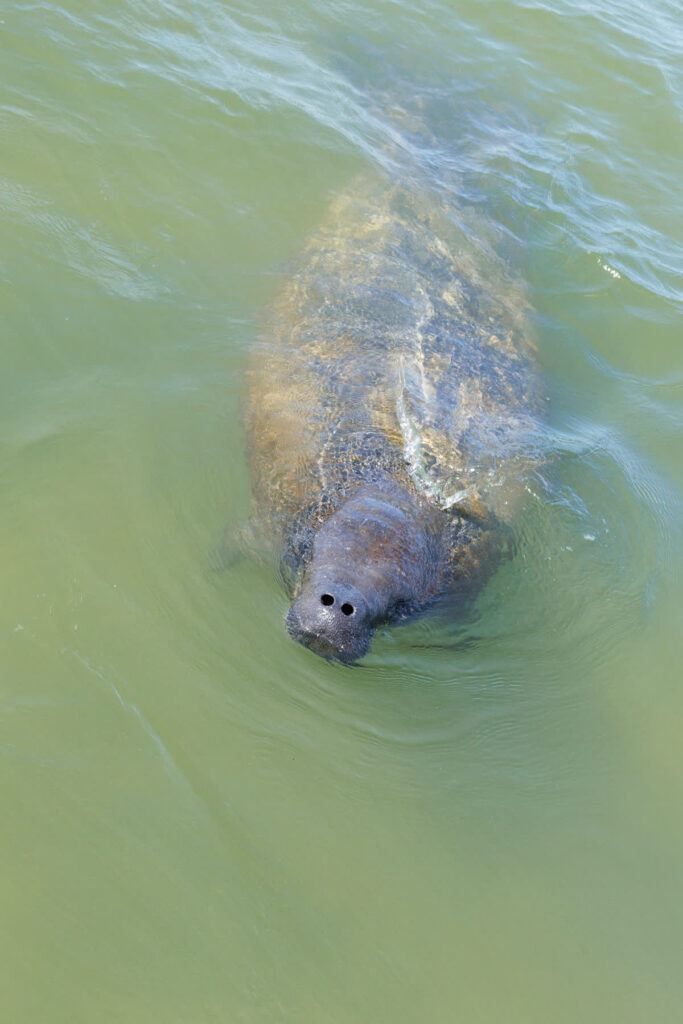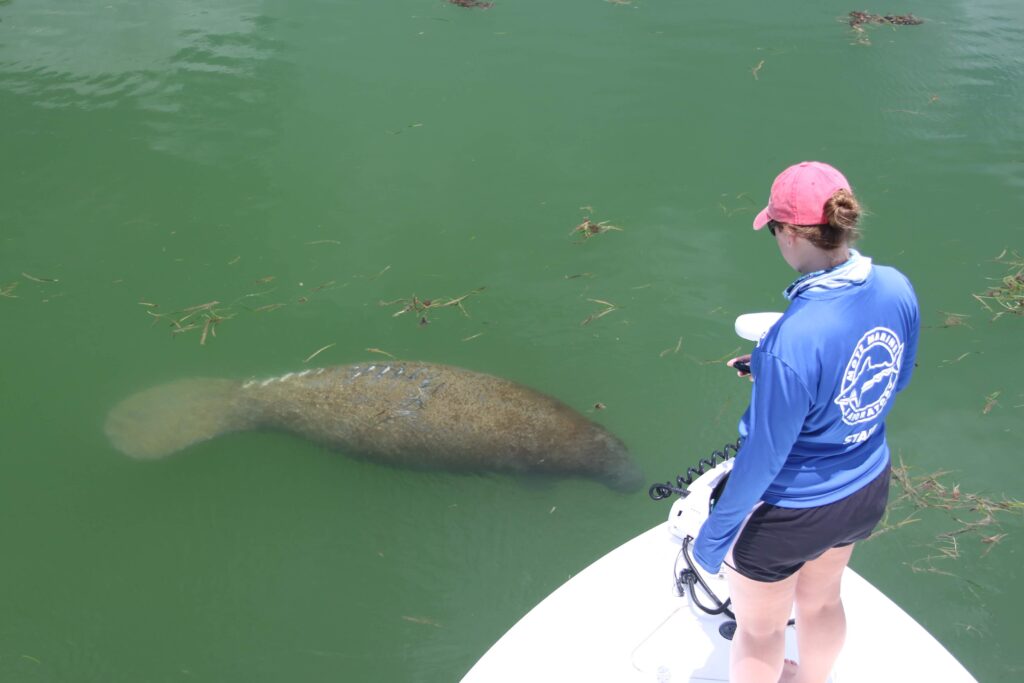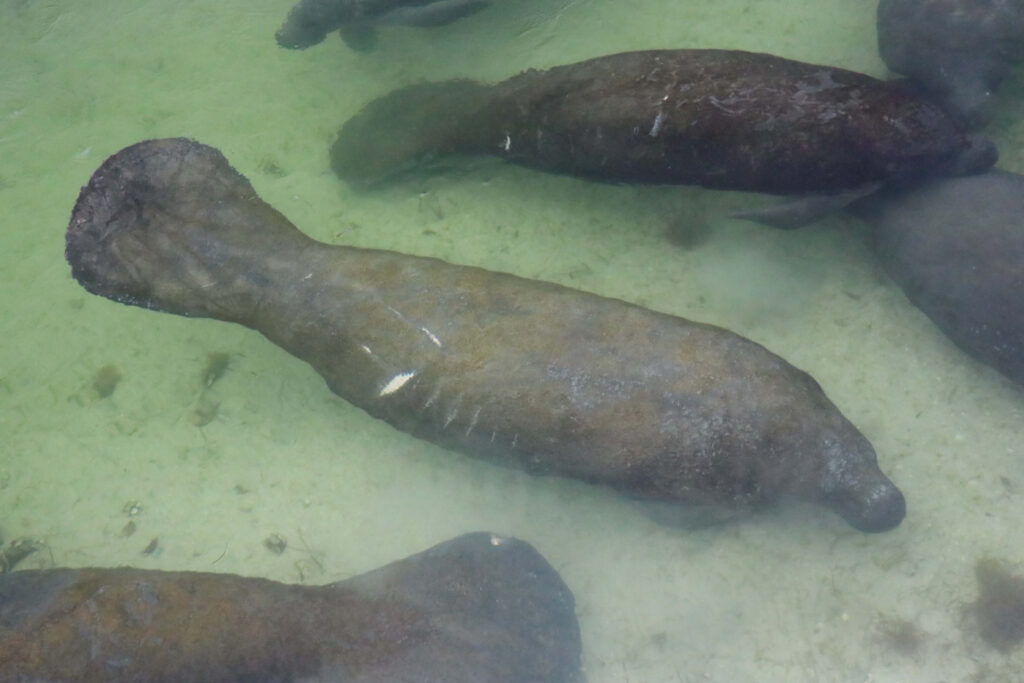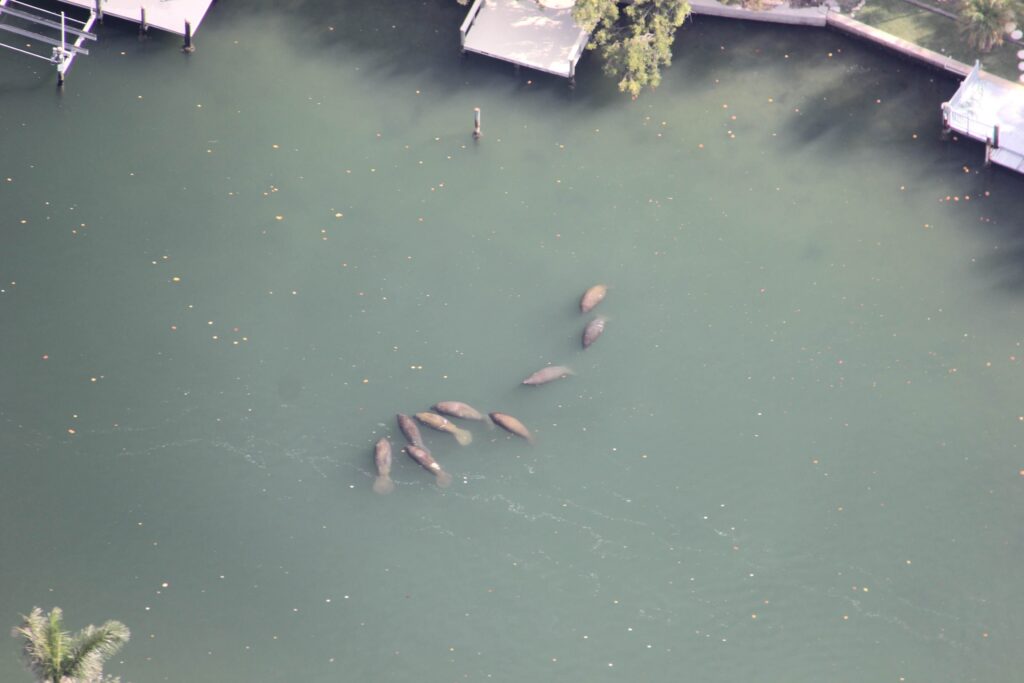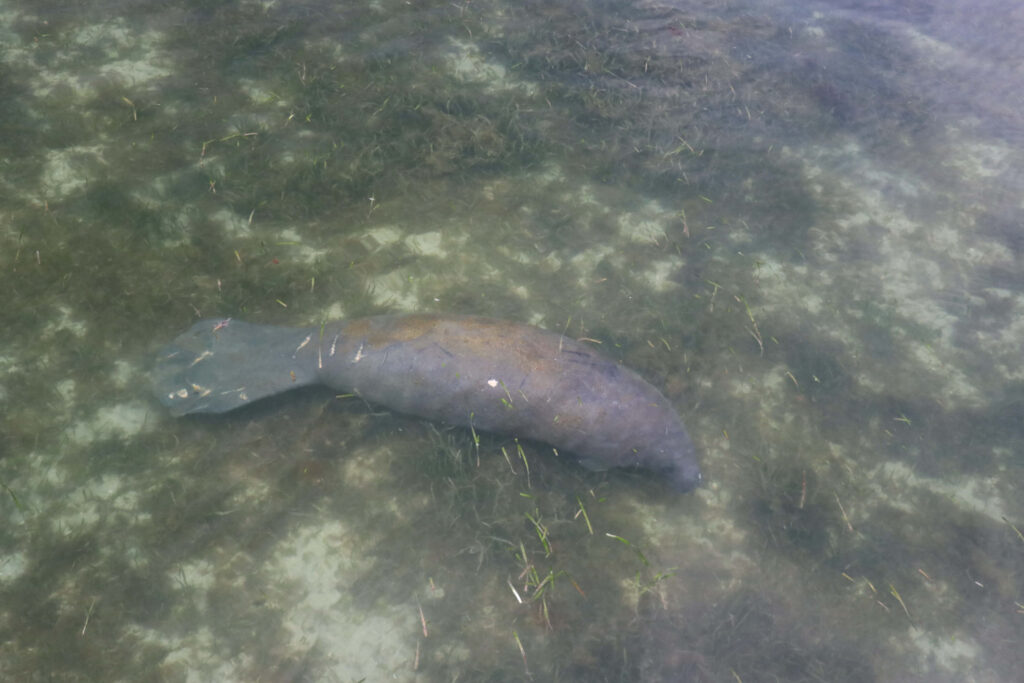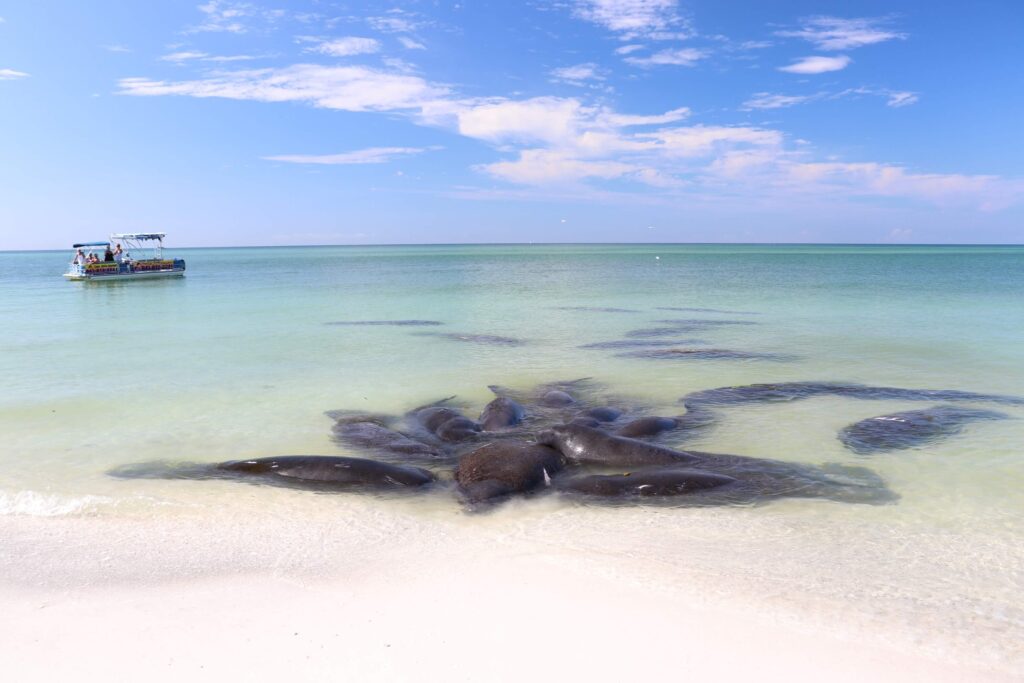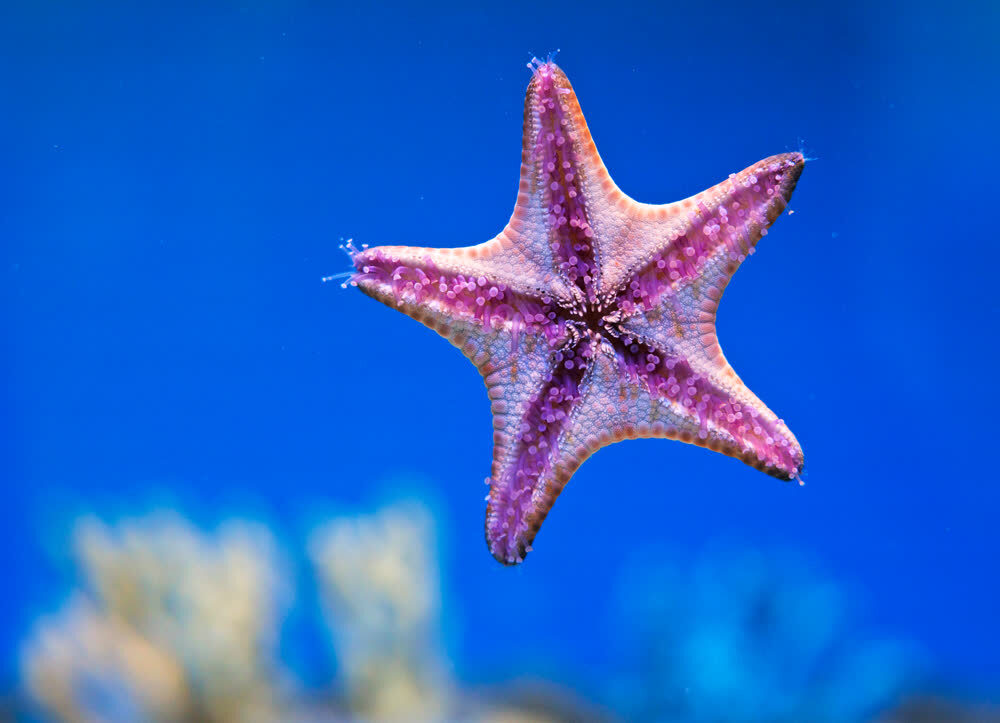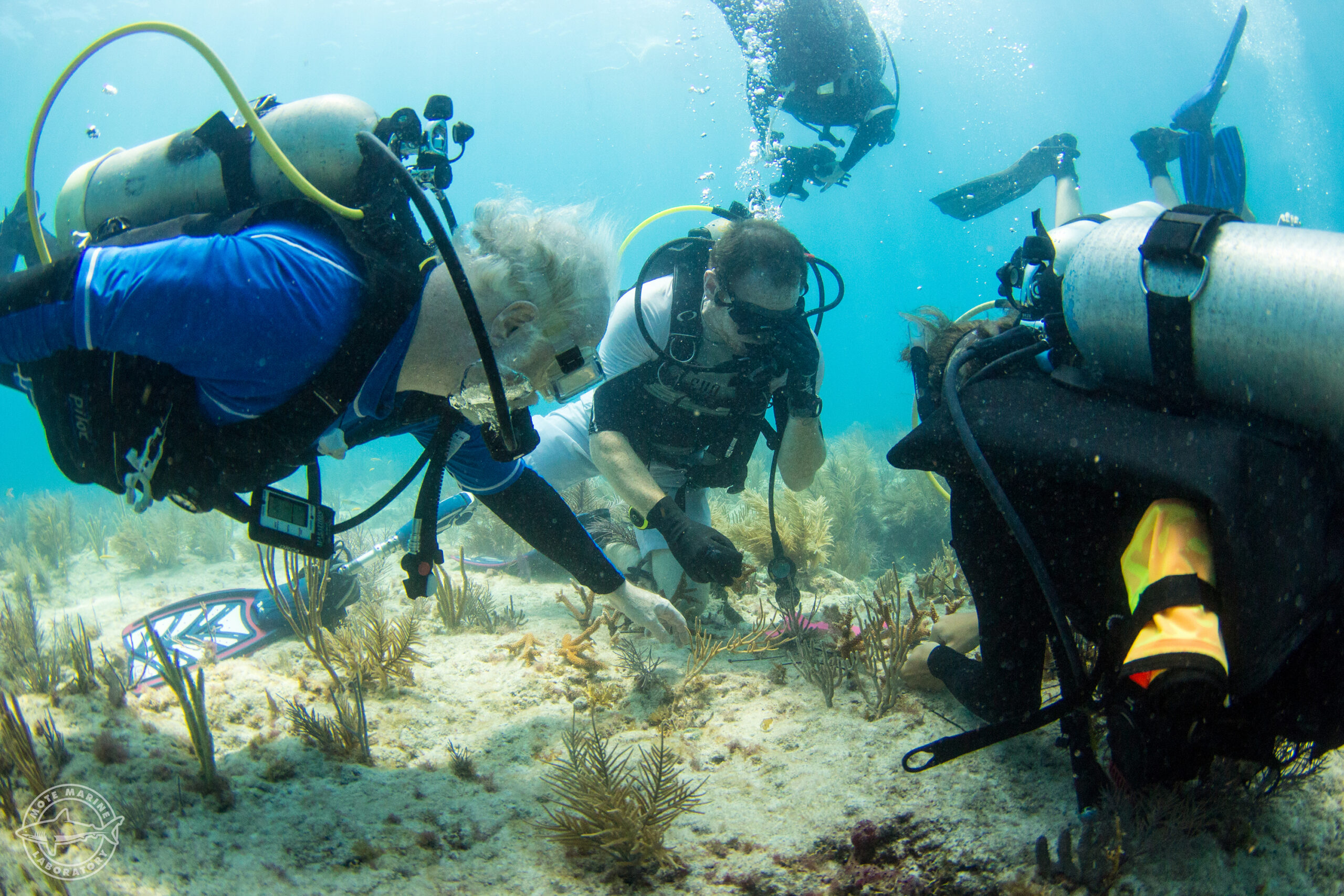For over 30 years, the Manatee Conservation Research Program (MCRP) has been involved in a host of research efforts involving manatee behavioral ecology, abundance and distribution, and population demographics, as well as habitat studies. This research provides timely, scientific-based information to guide conservation policy and management. Program staff also support efforts to inform the public on ways to better protect manatees.
Since 1997, the MCRP has partnered with the Florida Fish and Wildlife Conservation Commission and the U.S. Geological Survey Sirenian Project to manage an integrated sightings database, the Manatee Individual Photo-Identification System (MIPS). Photo-identification is a non-invasive technique used to identify individual animals over time. The MIPS database plays a crucial role in approximating vital statistics for Florida manatees, including survival and reproductive rates. These metrics are subsequently utilized in both state and federal evaluations concerning the status and recovery of the species. Locally, both long-term photo-identification and aerial surveys have proven valuable in the management of inland and coastal waters by striving to balance human activities with the sustainability of manatees and their habitat.
The MCRP team was managed by Dr. John Reynolds from 2001 until his passing on Dec. 23, 2017. Dr. Reynolds helped Mote become a beacon of conservation-focused science, particularly through his leadership of the MCRP, which continues the vital mission that he championed. Read about Reynolds’ life and legacy.
Current Research
Read about the wide variety of research led by MCRP scientists below. Much of our research is focused on the West Indian manatee (Trichechus manatus) which includes the subspecies Florida manatee (Trichechus manatus latirostris). These animals are protected by the Marine Mammal Protection Act of 1972, the Endangered Species Act of 1973, and the Florida Manatee Sanctuary Act of 1978.
The Manatee Research Program has a long history of conducting low-level aerial surveys to count manatees and other wildlife. Our current staff has a combined 25+ years of aerial survey experience, having conducted aerial projects over many of Florida’s waterways. The use of GIS is central in maintaining our sighting databases, analyzing survey data, and producing cartographic documentation of manatee distribution, habitat use patterns, and trends in counts.
Surveys of Florida Power & Light Company (FPL) power plants across the state have been conducted for four decades by former and current MCRP staff. Counts have exceeded 3,000 manatees on a single winter survey of warm-water refugia at 3 FPL plant locations. Single day counts at FPL’s Cape Canaveral Next Generation Energy Center’s warm-water discharge and nearby waters in Brevard County have approached 2,500+ manatees on several occasions.
The waterways of Sarasota County have been surveyed by MCRP staff for well over 30 years. These year-round surveys have provided one of the few long-term databases of habitat use and abundance of manatees in the state of Florida. These surveys also highlight locations where human activities and manatee habitat use might be in some conflict, thereby providing up-to-date information for balanced management decisions.
MCRP staff have participated in aerial surveys to assess state-wide abundance of manatees, organized by the Florida Fish and Wildlife Research Institute, since the 1990s.
MCRP staff have conducted photo-identification (photo-ID) surveys in waters of the southwestern coast of Florida for over 30 years, and in more recent years in southeastern Florida. Florida manatees can be identified using scars and mutilations on their trunks, flukes, and flippers that are acquired from incidents such as collisions with boats, lesions from cold stress, and entanglement in fishing gear. The process of photographing individual manatees and documenting them over time (photo-ID) provides a gold mine of information on manatee behavior and ecology, habitat use, life history (reproduction, mortality) and other factors necessary to optimally understand and conserve manatees. One important use of the photo-ID data is to generate regional adult survival estimates, which then translate into insights about population status and trends.
MCRP staff have genetically sampled manatees in southwestern Florida since 2006. In that time, the MCRP developed a unique skin scraping tool that takes a small sample of skin with minimal reactions from manatees. MCRP staff also collaborate with the Florida Fish and Wildlife Conservation Commission (FWC) with yearly biopsy sampling events during the colder months. Genetic samples are used for many purposes including determining paternity, sex, and as a mark-recapture tool.
The MCRP initiated a pilot/proof of concept study in 2018 to assess the efficacy of Unmanned Aerial Systems (UASs) for obtaining counts and documenting the distribution of manatees at winter sites in comparison with concurrent conventional aerial surveys. The UAS, flying at an altitude of 300-500 feet, produced high quality video from which counts and distribution of animals could be analyzed, producing similar results obtained by fixed wing-surveys. Manatees were not disturbed by, nor did they react to, the UAS during the trial.
In winter 2021-2022, MCRP staff, in coordination with other federal, state and non-profit agencies and organizations, conducted UAS surveys to observe body condition and behavior of manatees in order to identify animals in need of rescue. These surveys centered on the Indian River Lagoon, located on the east coast of Florida, a region that has been experiencing significant ecological issues, including a 96% loss in mean seagrass coverage. The loss of forage has resulted in an Unusual Mortality Event, or UME, in which hundreds of manatees have died from starvation since winter December 2020.
The use of UASs in marine mammal research is still relatively new, and government organizations overseeing protected species have taken a cautious approach on the permitting of their use. Studies such as the ones conducted by the MCRP, as well as other organizations around the globe, have shown UASs offer a safe, cost effective, and non-invasive method for conducting research. The MCRP plans to employ the use of UASs in other aspects of their research, including photo-identification and behavioral studies.
Previous / Other Research
In addition to our current research above, MCRP scientists have led a wide variety of other projects through the years to benefit manatees and other marine mammal species around the world. Below are highlights.
- Warm-water springs: MCRP staff have been involved in habitat assessment and manatee use studies of Florida springs, for which selected restoration could provide a long-term, industry independent source of warm water for hundreds of manatees in southwestern Florida. Formal efforts involved Sulphur Springs, Ulele Spring, and Lithia Spring.
- Thermal biology: One of the major threats to Florida manatees is cold stress. Cold Stress Syndrome (CSS) affects and kills Florida manatees in winter when water temperatures decrease below ~69°F. CSS symptoms include (but are not limited to) immune suppression, organ failure, lesions of heart, skin and other organs, eventually causing the death of the animal. The MCRP has conducted studies aimed at: 1) identifying environmental, physiological and morphological parameters that may influence Florida manatees’ susceptibility to cold stress, 2) developing preventive measures against CSS, and 3) identifying indicators for early diagnosis of CSS. The understanding of basic principles of manatee thermoregulation has been enhanced owing to investigations in the two trained resident Florida manatees at Mote, Hugh & Buffett, and through cooperation with Tampa’s Lowry Park Zoo and Homosassa Springs Wildlife State Park.
- Global research: Previous marine mammal projects led by former program manager Dr. John Reynolds included studies of age determination of bowhead whales and beluga whales in the Arctic, contaminants in Alaska Native subsistence foods and implications for human health, contaminant levels and their effects on sustainability of beluga whales in Cook Inlet and off Point Lay and health status of polar bears in Alaska.
- Dr. Reynolds often collaborated with Dr. Dana Wetzel, director of the Environmental Laboratory for Forensics (ELF) at Mote Marine Laboratory, on projects that examined levels and long-term sublethal effects of stressors (noise, contaminants, cold stress, disease) on significant biological functions in manatees and other marine mammals and fish globally. Their collaboration also resulted in the development of biomarkers for the determination of the sex of sturgeon at a very young age; a fact of considerable value to the caviar industry around the world.
- MCRP staff have conducted or collaborated on multiple research projects involving manatees fitted with satellite tags over the last 20+ years. These projects include behavioral and habitat use studies of manatees in southwestern and southeastern Florida.
Wildlife-friendly Tips for Boaters & Beachgoers

Manatee Conservation Research Program Team
Additional Program Information
- Castelblanco-Martinez, D.N., A. Alvarez-Aleman, R. Torres, A.L. Teague, S.L. Barton, K.A. Rood, E.A. Ramos, and A.A. Mignucci-Giannoni. 2021. First documentation of long-distance travel by a Florida manatee to the Mexican Caribbean. Ethology, Ecology, and Evolution, DOI: 10.1080/03949370.2021.1967457
- Hostetler, J.A., J. Martin, M. Kosempa, H.H. Edwards, K.A. Rood, S.L. Barton, and M.C. Runge. 2021. Reconstructing population dynamics of a threatened marine mammal using multiple data sets. Scientific Reports 11:2702. DOI: 10.1038/s41598-021-81478-z.
- Rood, K., A. Teague, S. Barton, A. Alvarez-Aleman, and E. Heib. 2020. First documentation of return movement from Cuba to the continental United States by a Florida manatee. Sirenews 71: 24-25.
- Powell J.A., K. M. Scolardi, and L. Keith-Diagne. 2019. Sirenians. Pp. 641-650 in Cochran, J. Kirk; Bokuniewicz, J. Henry; Yager, L. Patricia (eds.) Encyclopedia of Ocean Sciences, 3rd Edition, vol.[2]. Oxford: Elsevier.
- Wetzel, D. L., Reynolds III, J. E., Bonde, R. K., Schloesser, R. W., Schwierzke-Wade, L., & Roudebush, W. E. 2019. Enhancing reproductive assessments of the Florida manatee Trichechus manatus latirostris by establishing optimal time period and inhibin B baseline concentrations. Endangered Species Research, 39, 283-292.
- Wallace, R.L, S. Gilbert, J.E. Reynolds, III. 2019. Improving the integration of restoration and conservation in marine and coastal ecosystems: Lessons from the Deepwater Horizon disaster. BioScience, Volume 69, Issue 11: 920-927. https://doi.org/10.1093/biosci/biz103
- Erdsack, N., S.R. McCully Phillips, S.A. Rommel, D.A. Pabst, W.A. McLellan, and J.E. Reynolds, III. 2018. Heat flux in manatees: an individual matter and a novel approach to assess and monitor the thermal state of Florida manatees (Trichechus manatus latirostris). Journal of Comparative Physiology B, 188, 717-727.
- Reynolds, J.E., III, J.A. Powell, L.W. Keith Diagne, S.L. Barton, and K.M. Scolardi. 2018. Manatees. Pages 558-566 in B.Wursig, J.G.M. Thewissen, and K.M. Kovacs (eds.) Encyclopedia of marine mammals, 3rd Edition. Academic Press, San Diego, CA.
- Rommel, S. A., & Reynolds, J. E. (2018). Skeleton. In B. Würsig, J. G. M. Thewissen, & K. M. Kovacs (Eds.), Encyclopedia of marine mammals ( 3rd ed., pp. 861–871). London, UK: Academic Press.
- Reynolds, J.E., III. 2017. Florida Manatees: Biology, behavior, and conservation. JHU Press.
- Ponnampalam L.S., J.H. Fairul Izmal, K. Adulyanukosol, J.L.S. Ooi, and J.E. Reynolds, III. 2015. Aligning conservation and research priorities for proactive species and habitat management: the case of dugongs Dugong dugon in Johor, Malaysia. Oryx;49(4):743-749. doi:10.1017/S0030605313001580
- Laist, D. A. C. Taylor and J. E. Reynolds, III. 2013. Winter habitat preferences of Florida manatees (Trichechus manatus latirostris). PLOS One 8(3):e58978.
- Reynolds, J. E., III. 2013. Family Dugongidae. J. Kingdon, D. Happold, M. Hoffman, T. Butynski, M. Happold, and J. Kalina (eds.), Mammals of Africa, Volume 1: Introductory Chapters and Afrotheria. Bloomsbury, NY. 352pp.
- Reynolds, J. E., III. 2013. Family Trichechidae. J. Kingdon, D. Happold, M. Hoffman, T. Butynski, M. Happold, and J. Kalina (eds.), Mammals of Africa, Volume 1: Introductory Chapters and Afrotheria. Bloomsbury, NY. 352pp.
- Deutsch, C. J., and J. E. Reynolds, III. 2012. Florida manatee status and conservation issues. IN: Hines, E., J. E. Reynolds, III, A. A. Mignucci-Giannoni, L. V. Aragones, and M. Marmontel (eds.). Sirenian Conservation: Issues and Strategies in Developing Countries. University Press of Florida, Gainesville.
- Flamm, R.O., J. E. Reynolds, III, and C. Harnak. 2012. Mapping and characterizing the network of warm-water sites used by manatees (Trichechus manatus latirostris) along the southwestern coast of Florida. Environmental Management 51(1):154-166.
- Hines, E., J. E. Reynolds, L. Aragones, M. Marmontel, A. Mignucci-Gionnoni and D. Domning. 2012. The role of science in sirenian conservation in developing countries. IN: Hines, E., J. E. Reynolds, III, A. A. Mignucci-Giannoni, L. V. Aragones, and M. Marmontel (eds.). Sirenian Conservation: Issues and Strategies in Developing Countries. University Press of Florida, Gainesville.
- Hines, E., J. E. Reynolds, III, A. A. Mignucci-Giannoni,, L. V. Aragones, and M. Marmontel (eds.). 2012. Sirenian Conservation: Issues and Strategies in Developing Countries. University Press of Florida, Gainesville.
- O’Shea, T. J., and J. E. Reynolds, III. 2011. West Indian manatee. iPad application, Duke University and The Society for Marine Mammalogy.
- Reynolds, J. E., III, and C. D. Marshall. 2012. Vulnerability of sirenians. IN: Hines, E., J. E. Reynolds, III, A. A. Mignucci-Giannoni, L. V. Aragones, and M. Marmontel (eds.). Sirenian Conservation: Issues and Strategies in Developing Countries. University Press of Florida, Gainesville.
- Reynolds, J. E., III, B. Morales-Vela, I Lawler, and H. Edwards. 2012. Utility and design of aerial surveys for sirenians. IN: Hines, E., J. E. Reynolds, III, A. A. Mignucci-Giannoni, L. V. Aragones, and M. Marmontel (eds.). Sirenian Conservation: Issues and Strategies in Developing Countries. University Press of Florida, Gainesville.
- Reynolds, J.E., III and C.D. Marshall. 2012. Vulnerability of sirenians. IN: Hines, E., J. E. Reynolds, III, A. A. Mignucci-Giannoni, L. V. Aragones, and M. Marmontel (eds.). Sirenian Conservation: Issues and Strategies in Developing Countries. University Press of Florida, Gainesville.
- Rood, K.A., S.L. Barton, and C.A. Beck. 2012. Partnering for success: Florida manatee photo-identification. Page 32 in E.M. Hines, J.E. Reynolds, III, L.V. Aragones, A.A. Mignucci-Giannoni, and M. Marmomtel (eds.) Sirenian Conservation. University Press of Florida, Gainesville, FL.
- Wetzel, D. L., E. Pulster, and J.E. Reynolds, III. 2012. Organic contaminants and sirenians. IN: Hines, E., J. E. Reynolds, III, A. A. Mignucci-Giannoni, L. V. Aragones, and M. Marmontel (eds.). Sirenian Conservation: Issues and Strategies in Developing Countries. University Press of Florida, Gainesville.
- Marsh, H., T. J. O’Shea, and J. E. Reynolds, III. 2011. Ecology and Conservation of the Sirenia: Dugongs and Manatees. Cambridge University Press.
- Semeyn, D. J., Hebert, J., Cush, C. C., Scolardi, K. M., McBride, J. D., Grealish, D., Reynolds, J. E., III. 2011. Aerial surveys of manatees (Trichechus manatus) in Lee County, Florida, provide insights regarding manatee abundance and real time information for managers and enforcement officers. Journal of Coastal Conservation 15(4):573-583 (DOI: 10.1007/s11852-011-0146-3).
- Wilson, R. C., J. E. Reynolds III, D. L. Wetzel, L. Schweirzke-Wade, R. K. Bonde, K. F. Breuel and W. E. Roudebush. 2011. Secretion of anti-Mullerian hormone in the West Indian manatee (Trichechus manatus) with implications for assessing conservation status. Endangered Species Research 14(2):107-112.
- UNEP. 2010. Regional Management Plan for the West Indian Manatee (Trichechus manatus) compiled by Ester Quintana-Rizzo and John Reynolds III. CEP Technical Report No. 48. UNEP Caribbean Environment Programme, Kingston, Jamaica.
- Wetzel, D. L., J. E. Reynolds, III, J. M. Sprinkel, L. Schwacke, P. Mercurio and S. A. Rommel. 2010. Fatty acid signature analysis as a potential forensic tool for Florida manatees (Trichechus manatus latirostris). Science of the Total Environment 408: 6124–6133.
- Fonnesbeck, C. J., H. H. Edwards, and J. E. Reynolds III. 2009. A hierarchical covariate model for detection, availability and abundance of Florida manatees at a warm water aggregation site. IN: D. L. Thomson, E. G. Cooch, and M. J.Conroy (Eds.) Modeling Demographic Processes in Marked Populations Series: Environmental and Ecological Statistics , Vol. 3, Springer, pp 563-578.
- Lefebvre, L. W., Reynolds III, J. E., Ragen, T. J., Langtimm, C. A., and Valade, J. A., eds., 2009. Manatee Population Ecology and Management Workshop Proceedings: Gainesville, FL, April 2002. Special Publication, U.S. Geological Service. 66 pp.
- Reynolds, J. E., III and L. W. Lefebvre. 2009 Manatee Population Research and Its Applications to Management Strategies and Conservation. Pp. 6-16. IN: Lefebvre, L. W., Reynolds III, J. E., Ragen, T. J., Langtimm, C. A., and Valade, J. A., eds. Manatee Population Ecology and Management Workshop Proceedings: Gainesville, FL, April 2002. Special Publication, U.S. Geological Service. 66 pp.
- Reynolds, J. E., III , J. A. Powell, Jr., and C. A. Taylor. 2009. The manatees–Family Trichechidae (Trichechus manatus, T. senegalensis, and T. inunguis). IN: W. F. Perrin, B. Würsig, and H. Thewissen (eds.), Encyclopedia of Marine Mammals, 2nd Edition. Academic Press, San Diego, CA.
- Scolardi, K. M., L. H. Schwacke, J. K. Koelsch, J. E. Reynolds, III, T. J. Kessenich, J. M. Sprinkel, and J. G. Gannon. 2009. Trends in counts of manatees (Trichechus manatus latirostris) from 1987-2005 in waters of Sarasota County, Florida. Journal of Endangered Species Research 9:1-11.
- Schipper, J. et al. 2008. The biogeography of diversity, threat, and knowledge in the world’s terrestrial and aquatic mammals. Science 322:225.
- Tringali, M. D., S. Seyoum, S. L. Carney, M. C. Davis, M. A. Rodriguez-Lopez, J. E. Reynolds, III, and E. Haubold. 2008. Eighteen new polymorphic microsatellite markers for the endangered Florida manatee, Trichechus manatus latirostris. Molecular Ecology Notes 8:328-331.
- Twiss, J. R., Jr., R. J. Hofman, and J. E. Reynolds, III. 2008. Marine Mammal Conservation. IN: L.L. Rockwood, R. E. Stewart, and T. Dietz, eds. Foundations of Environmental Sustainability: The Co-Evolution of Science and Policy. Oxford University Press, London.
- Carney, S. L., E. E. Bolen, S. L. Barton, K. M. Scolardi, C. C. Englund, M. D. Tringali, and J. E. Reynolds, III. 2007. A minimally invasive method of field sampling for genetic analyses of the Florida manatee (Trichechus manatus latirostris). Marine Mammal Science 23(4):967-975.
- Edwards, H. H., K. H. Pollock, B. B. Ackerman, J. E. Reynolds, III, and J. A. Powell. 2007. Estimation of detection probability in manatee aerial surveys at a winter aggregation site. Journal of Wildlife Management 71(6):2052-2060.
- Gannon, J. G., K. M. Scolardi, J. E. Reynolds, III, J. K. Koelsch, and T. J. Kessenich. 2007. Habitat selection by manatees in Sarasota Bay, Florida. Marine Mammal Science 23(1):133-143.
- Miksis-Olds, J. L., P. L. Donaghay, J. H. Miller, P. L. Tyack, and J. E. Reynolds, III. 2007. Simulated vessel approaches elicit differential responses from manatees. Marine Mammal Science 23(3):629-649.
- Laist, D. L., and J. E. Reynolds, III. 2005. Florida Manatees, Warm-Water Refuges, and an Uncertain Future. Coastal Management 33:279-295.
- Laist, D. L., and J. E. Reynolds, III. 2005. Influence of Power Plants and Other Warm-Water Refuges on Florida Manatees. Marine Mammal Science 21(4):739-764.
- Craig, B. A., and J. E. Reynolds, III. 2004. Determination of manatee population trends along the Atlantic coast of Florida using a Bayesian approach with temperature-adjusted aerial survey data. Marine Mammal Science 20(3):386-400.
- Reynolds, J. E., III, S. A. Rommel, and M. E. Pitchford. 2004. The likelihood of sperm competition in manatees–explaining an apparent paradox. Marine Mammal Science 20(3):464-476.
- Glaser, K. S. (photographs) and J. E. Reynolds, III (text). 2003. Mysterious Manatees. University Press of Florida, Gainesville. ISBN 0-8130-2637-7: 187pp.
- Marsh, H., P. Arnold, M. Freeman, D. Haynes, A. Read, J. Reynolds, and T. Kasuya. 2003. Strategies for conserving marine mammals. Pp. 1-19. IN: N. Gales, M. Hindell and R. Kirkwood (eds.), Marine Mammals: Fisheries, Tourism, and Management Issues. CSIRO Publishing, Australia: 446pp.
- Reynolds, J. E., III and R. S. Wells. 2003. Dolphins, Whales and Manatees of Florida: A Guide to Sharing Their World. University Press of Florida, Gainesville. ISBN 0-8130-2687-3: 148pp.
- Ames, A. L., E. S. van Vleet, and J. E. Reynolds, III. 2002. Comparison of lipids in selected tissues of the Florida manatee (Order Sirenia) and bottlenose dolphin (Order Cetacea; Suborder Odontoceti). Comparative Biochemistry and Physiology Part B 132:625-634.
- Reynolds, J. E., III, D. P. DeMaster, and G. T. Silber 2002. Endangered and threatened species. Pp. 373-382. IN: W. F. Perrin, B. Würsig, and H. Thewissen (eds.), Encyclopedia of Marine Mammals. Academic Press, San Diego, CA.
- Reynolds, J. E., III and J. A. Powell, Jr. 2002. The manatees–Family Trichechidae (Trichechus manatus, T. senegalensis, and T. inunguis). Pp. 709-720. IN: W.F. Perrin, B. Würsig, and H. Thewissen (eds.), Encyclopedia of Marine Mammals, Academic Press, San Diego, CA.
- Wright, I. E., Reynolds, J. E. III, B. B. Ackerman, L. I. Ward, B. L. Weigle, and W. A. Szelistowski. 2002. Trends in manatee (Trichechus manatus latirostris) counts and habitat use in Tampa Bay, 1987-1994: Implications for conservation. Marine Mammal Science 18(1):259-274.
- Morales-Vela, B., D. Olivera-Gomez, J. E. Reynolds, III, and G. B. Rathbun. 2000. Distribution and habitat use by manatees Trichechus manatus manatus in Belize and Chetumal Bay, Mexico. Biological Conservation 95:67-75.
- Rommel, S. A., and J. E. Reynolds, III. 2000. Diaphragm structure and function in the Florida manatee (Trichechus manatus latirostris). The Anatomical Record 259(1):41-51.
- Reynolds, J. E., III. 1999. Efforts to Conserve the Manatees. Pp. 267-295. IN: J.R. Twiss, Jr. and R. R. Reeves (eds.). Conservation and Management of Marine Mammals. Smithsonian Institution Press, Washington, D.C.: 471pp.
- Reynolds, J. E. III, and S. A. Rommel (eds.) 1999. Biology of Marine Mammals. Smithsonian Institution Press, Washington, D.C. ISBN 1560983752: 578pp. Converted to e-book: summer 2013.
- Reynolds, J. E., III, S. A. Rommel, and D. K. Odell. 1999. Marine Mammals of the World. Pp. 1-14. IN: Reynolds, J. E., III and S. A. Rommel (eds). Biology of Marine Mammals. Smithsonian Institution Press, Washington, D.C.: 578pp.
- Reynolds, J. E. III, and D. K. Odell. 1991. Manatees and Dugongs. Facts on File, Inc., New York. ISBN 0-8160-2436-7: 192 pp. Second printing: October 1993. Fourth printing: March 1998.
- Reynolds, J. E., III, and K. D. Haddad (eds.). 1990. Report of the Workshop on Geographic Information Systems as an Aid to Managing Habitat for West Indian Manatees in Florida and Georgia. Florida Marine Research Publication Number 49: 98pp.
OTHER NOTABLE PUBLICATIONS
- Gales, N., P. Best, D. Bowen, D. Johnston, K. Kovacs, C. Littnan, W. Perrin, J. Reynolds, and P. Thompson. 2009. Guidelines for the treatment of marine mammals in field research. Marine Mammal Science 25(3): 725-736.
- Merrick, R. G. T. Silber, J. E. Reynolds, III, and D. P. DeMaster. 2009. Endangered and threatened species. IN: W. F. Perrin, B. Würsig, and H. Thewissen (eds.), Encyclopedia of Marine Mammals, 2nd Edition. Academic Press, San Diego, CA.
- Reynolds, J. E., III, H. Marsh, and T. J. Ragen. 2009. Marine Mammal Conservation. Journal of Endangered Species Research 7(1):23-28.
- Rommel, S. A., and J. E. Reynolds, III. 2009. Postcranial skeleton of marine mammals. IN: W. F. Perrin, B. Würsig, and H. Thewissen (eds.), Encyclopedia of Marine Mammals, 2nd Edition. Academic Press, San Diego, CA.
- George, J. C., D. L. Wetzel, L. Dehn, T. M. O’Hara, T. M. Robertson, R. G. LeDuc, and J. E. Reynolds, III. 2008. An Analysis of Ancient Bowhead Whale Mangtak from Gambell Alaska: What can it tell us? International Whaling Commission SC/60/E?
- Wetzel, D. L., J. E. Reynolds, III, and W. W. Christie. 2007. Identification of fatty acids by picolinyl ester derivatives. Marine Mammal Science 23(4):989-990.
- Reynolds, J. E., III, D. L. Wetzel, and T. M. O’Hara. 2006. Omega-3 fatty acids and omega-6 fatty acids in blubber of bowhead whales (Balaena mysticetus): health implications for subsistence-level cultures. Arctic 59(2):155-164.
- Ragen, T. J., R. R. Reeves, J. E. Reynolds, III, and W. F. Perrin. 2005. Future Directions in Marine Mammal Research: A Synthesis of the Consultation. Pp. 179-183. IN: Reynolds, J. E., III, W. F. Perrin, R. R. Reeves, T. J. Ragen, and S. Montgomery (eds.). Marine Mammal Research: Beyond Crisis Management. Johns Hopkins University Press, Baltimore, MD.
- Reynolds, J. E., III. 2005. The paradox of marine mammal science and conservation: Maddening inertia during accelerated change. Pp. 1-3. IN: Reynolds, J. E., III, W. F. Perrin, R. R. Reeves, T. J. Ragen, and S. Montgomery (eds.). Marine Mammal Research: Beyond Crisis Management. Johns Hopkins University Press, Baltimore, MD.
- Reynolds, J. E., III, W. F. Perrin, R. R. Reeves, T. J. Ragen, and S. Montgomery (eds.). 2005. Marine Mammal Research: Conservation Beyond Crisis. Johns Hopkins University Press, Baltimore, MD. ISBN 0-8018-8255-9:223pp.
- Langtimm, C.A., C.A. Beck, H.H. Edwards, K.J. Fick-Child, B.B. Ackerman, S.L. Barton, and W.C. Hartley. 2004. Survival estimates for Florida manatees from the photo-identification of individuals. Marine Mammal Science, 20(3):438-463.
- O’Hara, T., P. Hoekstra, C. Hanns, D. Muir, D. Wetzel, J. Reynolds. 2004. A preliminary assessment of the nutritive value of select tissues from the bowhead whale based on suggested nutrient daily intakes. International Whaling Commission Scientific Committee Report SC/56/E2:1-19.
- Wetzel, D. L., and J. E. Reynolds, III. 2004. Definitive identification of fatty acid constituents in marine mammal tissues. Canadian Journal of Fisheries and Aquatic Sciences 61(4):554-560.
- Reynolds, J. E., III, R. S. Wells, and S. D. Eide. 2000. The Bottlenose Dolphin–Biology and Conservation. University Press of Florida, Gainesville. ISBN 0-8130-1775-0: 288pp. Second printing: July 2013. ISBN 978-0-8130-4934-2

